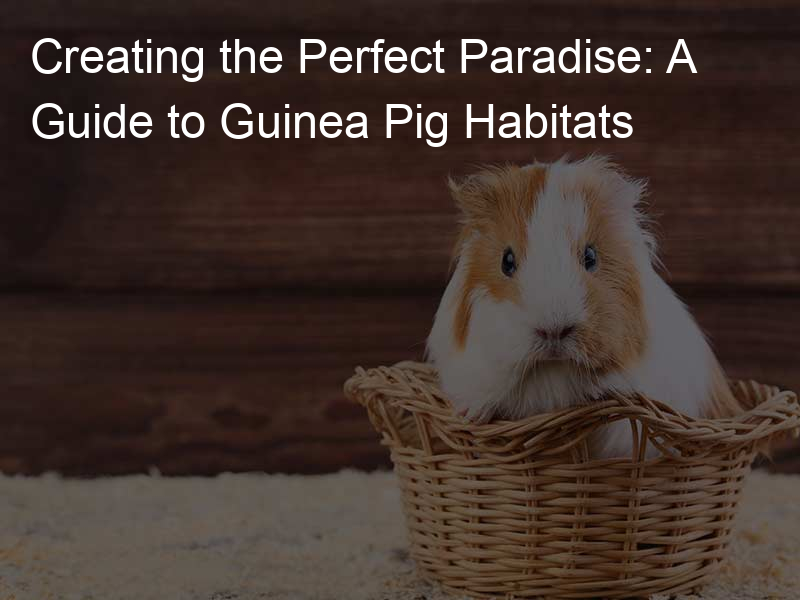Introduction to Guinea Pig Habitats
Also known as cavies, are small, sociable, and cute creatures that make wonderful pets. They require a specific type of environment to thrive and stay healthy. This article aims to provide a comprehensive guide on creating the perfect habitat.
- A Suitable Habitat for Guinea Pigs
They love to explore, play, and exercise. It provides them with a safe and comfortable space to live and play. A well-designed habitat can also help prevent health issues such as obesity, boredom, and stress.
- Key Factors to Consider When Creating a Guinea Pig Habitat
- Size: Needs plenty of space to move around. The minimum recommended size for a guinea pig cage is 7.5 square feet for one guinea pig, and 10.5 square feet for two.
- Bedding: They need soft, absorbent bedding to keep their habitat clean and comfortable. Avoid cedar or pine shavings, as they can cause respiratory problems.
- Enrichment: Love to play and explore. Provide toys, tunnels, and hideouts to keep them entertained.
- Food and water: Has constant access to fresh, clean water and a balanced diet.
Indoor Guinea Pig Habitat
Choosing the Right Guinea Pig Cage
-
- Size and Design Considerations for a Guinea Pig Cage
Needs plenty of space to move around and play. A cage that is too small can lead to stress and health problems. The recommended minimum cage size for one, is 7.5 square feet, but bigger is always better. In terms of design, opt for a cage with a solid floor to protect your pet’s feet from injury. Cages with multiple levels can provide extra space for exploration, but make sure ramps are safe and easy for your guinea pig to navigate.
-
- Materials to Avoid in a Guinea Pig Cage
With wire flooring, as this can cause injury to your pet’s feet. Also, steer clear of cages made from soft woods like cedar or pine, as these can release harmful oils. Instead, opt for cages made from safe, non-toxic materials like hard plastic or metal.
Setting Up the Guinea Pig Cage.
- Location for the Cage
It’s best to place their cage in a quiet, yet central part of your home where they can see and hear what’s going on. Avoid areas with direct sunlight or drafts, as these can be harmful to your pet. The cage should also be placed off the ground to protect your guinea pig from other pets or small children.
- Setting Up Bedding and Other Essentials
Opt for absorbent, dust-free bedding such as paper-based or aspen shavings. Avoid cedar or pine shavings, as these can cause respiratory issues. Change the bedding at least once a week to maintain cleanliness.
Other essentials include a water bottle, food dish, and toys to keep your guinea pig entertained. A hidey house is also a must-have, need a place to retreat and feel safe.
- Ensuring the Cage is Safe and Secure
They are curious creatures and may try to escape if given the chance. Ensure the cage has a secure latch and that there are no gaps or sharp edges that could harm your pet. Regularly check the cage for any potential hazards and fix them immediately.
Outdoor Guinea Pig Habitat
Creating a Safe and Comfortable Guinea Pig Enclosure
- Choosing the right location for the enclosure
- Setting up the enclosure with necessary amenities
- Ensuring the enclosure is predator-proof
Choosing the Right Location for the Enclosure
Shaded from direct sunlight, as guinea pigs can overheat quickly. The location should also be free from drafts and flooding. A flat, grassy area is ideal as it provides a natural and comfortable surface for your pet.
Setting Up the Enclosure with Necessary Amenities
Should be spacious enough for your guinea pig to move around freely. It should also include a sheltered area where your pet can hide and rest. The enclosure should be equipped with food and water dishes, as well as toys to keep your pet entertained.
Ensuring the Enclosure is Predator-Proof
Should have a solid base to prevent burrowing predators, and the top should be covered to protect from birds of prey. The sides of the enclosure should be made of a sturdy material that cannot be easily chewed through or broken.
Creating a safe and comfortable outdoor guinea pig habitat requires careful planning and regular maintenance. By considering the location, amenities, and security of the enclosure, you can provide your guinea pig with a wonderful outdoor home.
Guinea Pig House: A Cozy Retreat
-
- A Guinea Pig House within the Habitat
It’s a place where they can hide when they feel threatened, rest when they’re tired, and even play when they’re in a playful mood. According to Wikipedia, guinea pigs are prey animals, and having a safe place to hide is for their well-being.
-
- Guinea Pig House
Consider the size, material, and design. The house should be spacious enough for your guinea pig to move around comfortably. Opt for non-toxic, chew-safe materials to ensure your pet’s safety. The design should be simple, with no sharp edges or small parts that could harm.
-
- Setting up the House in the Habitat
It should be placed in a quiet, low-traffic area to minimize stress. Ensure it’s not directly under a heat source or in a drafty area. Adding soft bedding inside the house can make it more comfortable for your pet.
House plays a pivotal role in your pet’s habitat. It not only provides a cozy retreat but also contributes to their overall health and happiness. So, invest time in choosing the right house and setting it up properly in the habitat.
Optimizing the Guinea Pig Environment
Temperature and Lighting
-
- Maintaining optimal temperature in the habitat:
Best in a temperature range of 65 to 75 degrees Fahrenheit. This range mimics their natural habitat and keeps them comfortable. Too hot or too cold environments can lead to health issues like heat stress or hypothermia. Monitor the temperature of your pet’s habitat regularly. A simple indoor thermometer can help you keep track.
-
- Ensuring adequate lighting for the guinea pig:
They should have exposure to natural daylight but not direct sunlight, which can cause overheating. At the same time, they need a dark period for rest. A well-lit room with indirect sunlight during the day and darkness at night is ideal. Avoid placing their cage near windows where there might be drafts or extreme temperature changes.
Guinea Pig Care: Cleanliness and Hygiene
-
- Regular cleaning of the habitat
They are clean animals by nature, but they rely on their caretakers to keep their living environment clean. The habitat is to prevent the build-up of bacteria and harmful substances that can cause diseases. It’s recommended to do a full clean of the cage at least once a week. This includes removing all bedding, washing the cage with a pet-safe disinfectant, and replacing the bedding with fresh, clean material.
-
- Keeping the guinea pig clean and healthy
Regular brushing helps to remove loose hair and dirt, and it’s a great way to bond with your pet. Depending on the breed, some guinea pigs may require more frequent grooming than others.
Bathing should be done sparingly, as it can strip the natural oils from their skin and cause dryness. Only bathe your guinea pig if they are particularly dirty or if recommended by a vet. Always use a small animal shampoo and ensure they are thoroughly dried afterwards to prevent them from getting cold.
Regular health checks are also important. This includes checking their teeth, ears, and nails. If you notice any changes in their behavior or appearance, it’s best to consult a vet.
Guinea Pig Living Conditions
- Guinea Pig Behavior and Social Needs
They thrive in the company of their own kind and can become lonely if left alone. Studies have shown who live in pairs or small groups are generally happier and healthier. They communicate using a variety of sounds such as squeaks, purrs, and chirps, and they express their feelings through body language. These behaviors can help you better care for your pet.
- Importance of Exercise and Play in the Habitat
A well-designed habitat should include plenty of space for your guinea pig to run around and explore. Toys, tunnels, and hideouts can provide mental stimulation and opportunities for play. Regular exercise helps keep your guinea pig’s weight in check, prevents boredom, and promotes overall health.
Along with providing ample opportunities for exercise and play, can significantly enhance their living conditions. By taking these factors into account, you can create a comfortable and stimulating environment for your pet.
Conclusion: Creating the Perfect Guinea Pig Paradise
-
- Recap of key points:
Started with an introduction to guinea pig habitats, discussing the importance of creating a safe and comfortable environment for your pet. We then explored the differences between indoor and outdoor habitats, highlighting the pros and cons of each.
Also discussed the concept of a guinea pig house, a cozy retreat within the habitat where your pet can rest and hide. We emphasized the importance of optimizing the guinea pig environment, ensuring it has enough space, the right temperature, and plenty of toys and activities to keep your pet stimulated.
Discussing the importance of cleanliness, diet, and social interaction in ensuring your pet’s well-being.
-
- Final thoughts on guinea pig care and habitat setup:
Creating the perfect habitat for your guinea pig requires time, effort, and a deep understanding of your pet’s needs. It’s not just about providing a space for them to live, but creating an environment where they can thrive.






